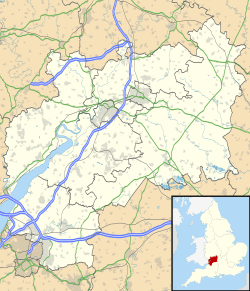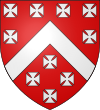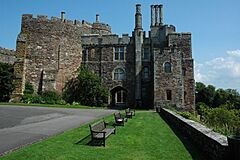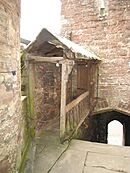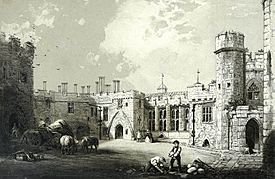Berkeley Castle facts for kids
Quick facts for kids Berkeley Castle |
|
|---|---|
| Berkeley, Gloucestershire | |
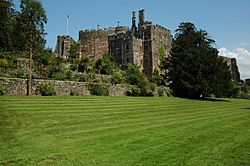
Berkeley Castle viewed from the southwest
|
|
| Coordinates | 51°41′19″N 02°27′25″W / 51.68861°N 2.45694°W grid reference ST685989 |
|
Listed Building – Grade I
|
|
| Official name | Berkeley Castle |
| Designated | 21 October 1952 |
| Reference no. | 1340692 |
Berkeley Castle is a historic castle in the town of Berkeley, Gloucestershire, in England. The castle's story began in the 11th century. It is so important that it is officially protected as a Grade I listed building.
The castle is famous as the place where King Edward II is said to have been murdered in 1327. For most of its history, it has been owned by the Berkeley family. They first built the stone castle in the 12th century and have owned it ever since, except for a short time under the Tudor kings and queens.
The Berkeley family still owns the castle today. Since 1956, Berkeley Castle has been open for the public to visit. People can explore the castle and its grounds from April to November on certain days. The castle can also be rented for special events like weddings.
Contents
How Was Berkeley Castle Built?
The first castle at Berkeley was built around 1067, right after the Norman invasion of England. It was a simple fort made of earth and wood, called a motte-and-bailey castle. It was built by a Norman lord named William FitzOsbern.
Later, a man named Robert Fitzharding was given the castle by King Henry II. He was a rich and powerful supporter of the king. Fitzharding and his family, the Berkeleys, began rebuilding the castle in stone.
Between 1153 and 1156, Fitzharding built the circular stone tower, called a shell keep. This was likely built on top of the old earthen mound. After that, a strong curtain wall was built around the castle between 1160 and 1190.
Many other parts of the castle were added in the 14th century. This includes Thorpe's Tower, the inner gatehouse, and other buildings inside the castle walls.
The Mysterious Death of King Edward II
In 1327, King Edward II was removed from the throne by his wife, Queen Isabella, and her powerful ally, Roger Mortimer. The king was taken as a prisoner to Berkeley Castle. He was held there for five months, from April to September.
During his time at the castle, some of the king's supporters managed to break in and rescue him. However, he was quickly captured again and brought back. To make another rescue harder, his captors may have moved him between different castles before returning him to Berkeley.
Official records say that King Edward II was murdered at the castle on September 21, 1327. Old history books, like Holinshed's Chronicles, describe his death in a secret and brutal way. The story says he was killed so that there would be no marks on his body. This would make it look like he died from an illness.
The room where the king was supposedly held prisoner and murdered can still be visited today. Next to it is a deep dungeon. Some people say that every year on September 21, strange sounds can be heard from the dungeon.
After the king's death, his body was prepared for burial and lay in the castle's chapel for a month. Then, it was taken to Gloucester Abbey (now Gloucester Cathedral) to be buried. The owner of the castle, Thomas de Berkeley, was accused of being involved in the murder. However, he said he was not at the castle when it happened. In 1337, he was cleared of all charges.
What Happened at the Castle Later?
In the 14th century, the castle's Great Hall was given a new roof. It was in this hall that the last court jester in England, named Dickie Pearce, sadly died after falling from the balcony. His grave is in the churchyard next to the castle.
During the First English Civil War in the 1640s, the castle was held by supporters of the king. In 1645, it was captured by the opposing army. Cannons were fired at the castle from the roof of the nearby church. After the castle surrendered, its outer walls were partly destroyed. The Berkeley family was allowed to keep their home, but they were told never to repair the damage. This rule is still followed today.
In the early 18th century, the 4th Earl of Berkeley planted a special pine tree. It was said to be grown from a cutting taken from a tree at the famous Battle of Culloden in Scotland.
In the early 20th century, the 8th Earl of Berkeley repaired and updated parts of the castle. He also added a new porch that matched the castle's old Gothic style.
Berkeley Castle is the third-oldest castle in England that has always been lived in, after the Tower of London and Windsor Castle. It is also the oldest castle to be owned by the same family for so long.
Berkeley Castle on TV and in Movies
Because of its amazing history and appearance, Berkeley Castle has been used as a filming location for many movies and TV shows.
It was used for scenes in the 2003 TV movie The Other Boleyn Girl. The castle and its grounds were also the setting for a castle in the musical comedy show Galavant. In 2019, it was a major location for the historical drama The Spanish Princess.
The castle was also featured on the American TV show Who Do You Think You Are?. Actress Courteney Cox visited the castle and learned that she was a direct descendant of the Berkeley family who lived there during the time of King Edward II's death.
See also


